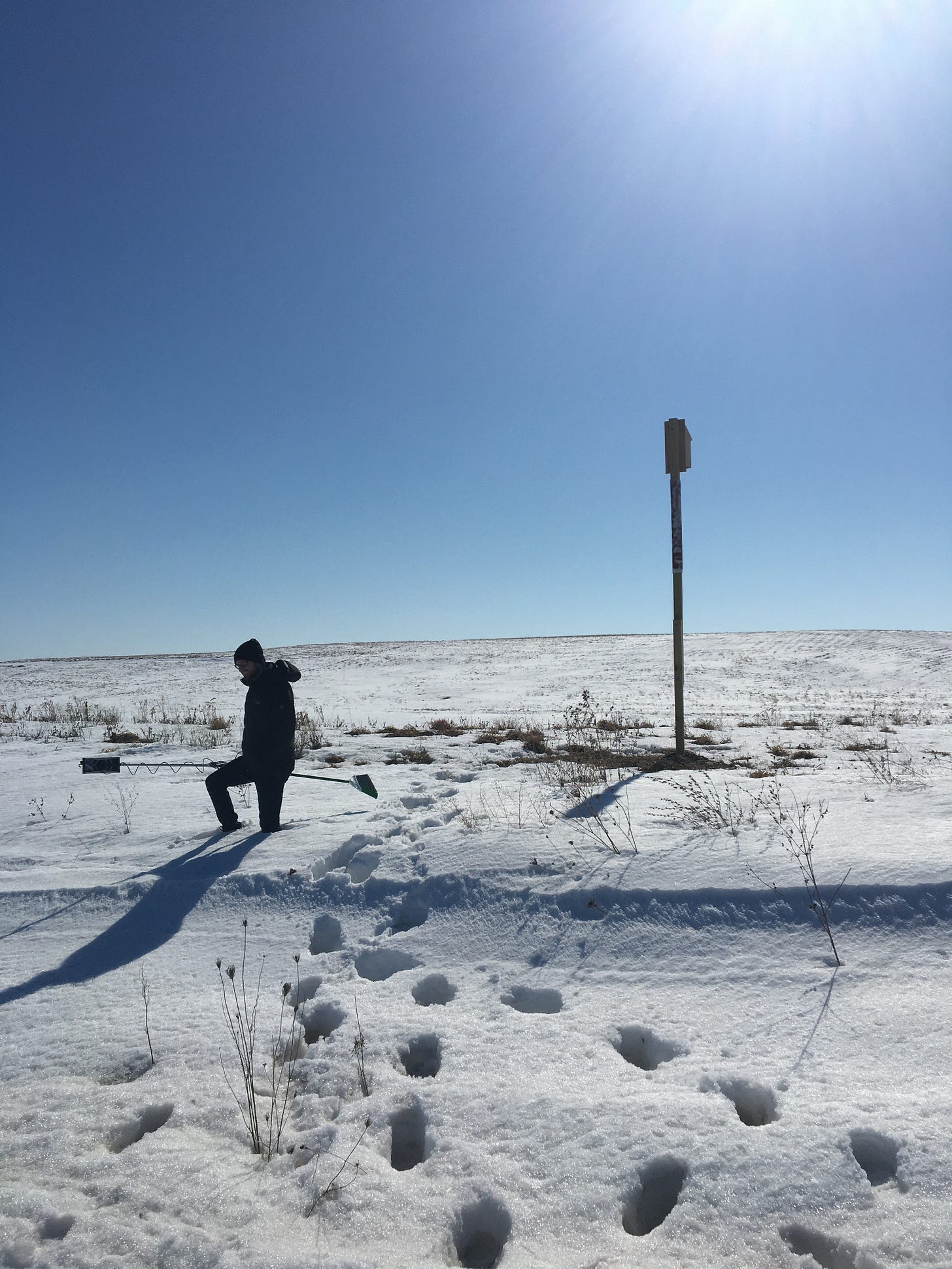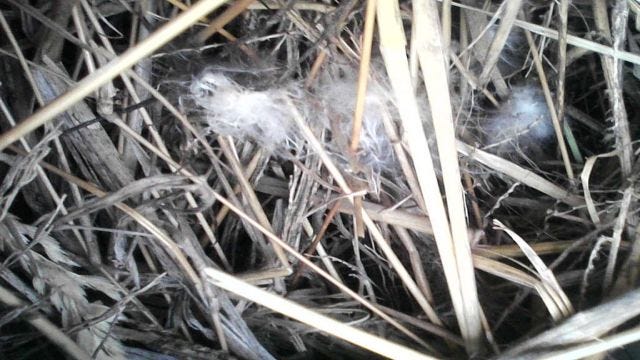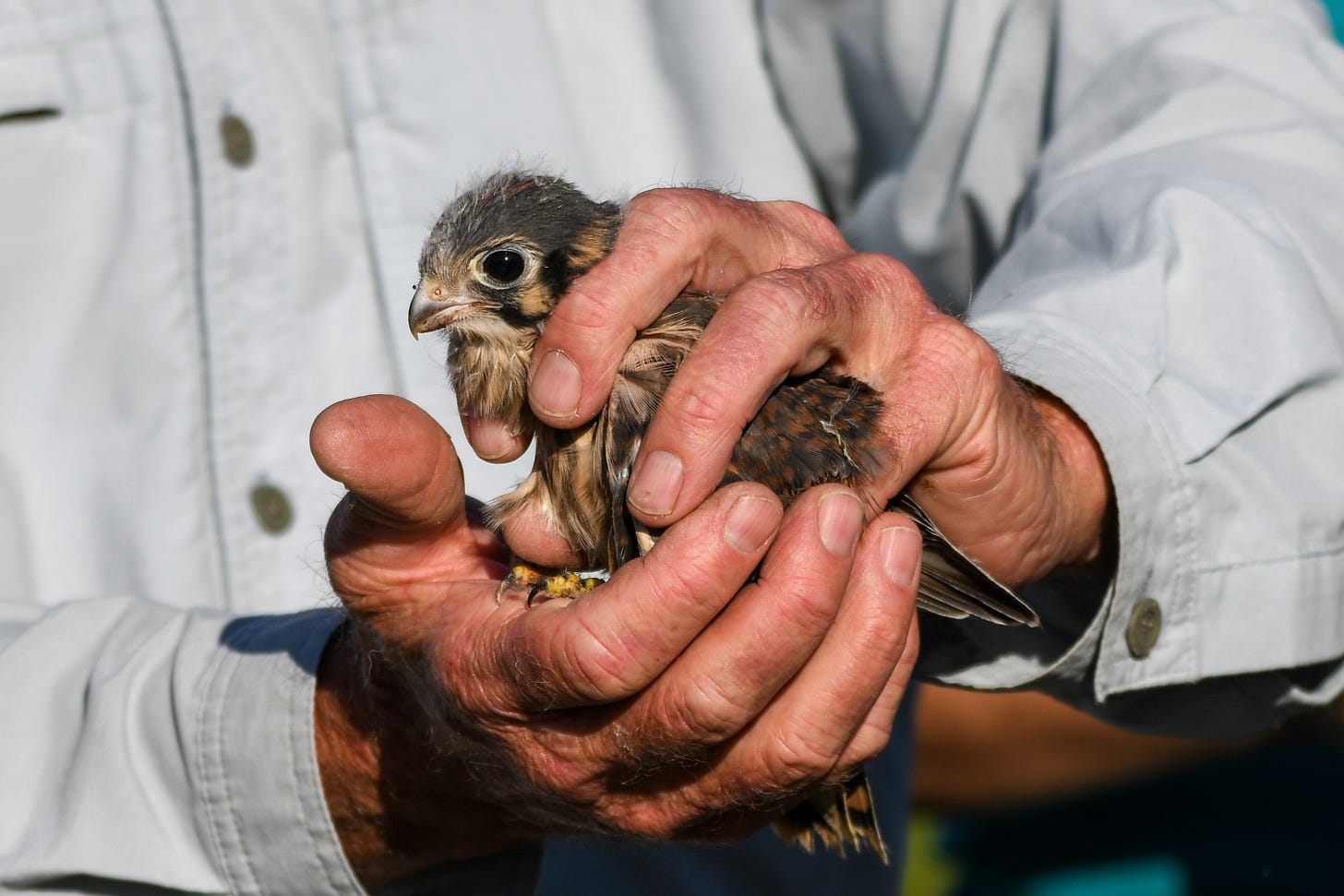How to please a badger
Welcome to Owl My Children, a monthly newsletter where I relate a dramatic bird anecdote and talk about how great Michael is.
But first, a report from Madison, where our AQI is still over 200
June hasn’t been a great month to be outside. In Madison we’ve been dealing with poor air quality since Memorial Day, and though some days have been decent, things took a turn this Monday and we’ve been trapped inside all week. I’m grateful to have central air conditioning and a HEPA filter, and being stuck inside means that Michael and I have no excuse not to start packing for our move to Pittsburgh.
Of course, I’ve been wondering about the birds, with their teeny tiny lungs and delicate feathers. My friendly neighborhood house finches seem as active as ever despite the smoke. Based on my internet searches, there has been very limited research done on how wildfire smoke impacts birds, but if you are experiencing poor air quality in Canada or the US and you notice any unusual bird behavior, a researcher at UCLA is collecting observations here. Hope you and your birds are all hanging in there!
On to our dramatic anecdote.
The end of my kestrel era
In a few weeks, I’ll be wrapping up my involvement in Madison Audubon’s Kestrel Box Monitoring program. The goal of this program is to provide safe nest spaces for American kestrels, which are North America's smallest falcons. Kestrels can usually be found in meadows or open fields, but they build their nests in the cavities of trees. The kestrel population in Wisconsin has declined rapidly because of the loss of those crucial nesting trees due to land development; the Breeding Bird Survey estimated a kestrel population decline of 41% between 1966 and 2014.
In an attempt to provide more viable nesting spots for kestrels, a lot of programs across the country have installed nest boxes in kestrel habitat—if you see a box on the top of a very tall pole, near an open field or on the side of the road, that’s probably a kestrel box. My volunteer program manages over 220 boxes across south-central Wisconsin alone. I’m only in charge of one.
In three years I’ve never had a kestrel use my box, but I haven’t left the program because I’m so darn hopeful. Every year we get to help band the kestrel chicks in successful boxes, and that alone is enough to fuel my optimism.
A kestrel chick in the process of being banded last July. All kestrel banding was performed by licensed banders. (Photo by me.) (These are not my hands.)
Once a week during nesting season (April-June), I drive out to my box at the edge of a farmer’s field and check to see whether it’s occupied by a kestrel. I bought a wireless endoscope for this purpose, which I attach to the end of an extending orange pool-cleaner. The endoscope lets me “look” into the box without having to take the box down. Michael of course used it to look down his own throat, because he was curious. This is a man who is about to receive his PhD.
During my first year, before I bought the pool-cleaner, I simply duct-taped two brooms together; the only problem was that, even taped together, the brooms weren’t tall enough.
Michael with our kestrel box back in 2021, preparing for nesting season. (Photo by me)
Anyway, if a kestrel nests in my box, I get to record the number of eggs and/or chicks. Once the chicks reach a certain age, Madison Audubon goes out to the nest to band them, which enables us to track where the kestrels go from year to year and to determine how kestrels are holding up as a species.
If a different native bird ends up using my box—like a tree swallow or Eastern screech owl—I can leave it there and feel proud that a native bird has chosen me. If it’s an invasive species, such as a European starling or house sparrow, I’m supposed to remove the nest.
This has all been fine and dandy for nearly three years. My first year, I got a tree swallow nest. The feathers in the nest were beautiful, white, and soft—the most delicate feathers I’ve ever seen in nature. And tree swallows remind me of little sky dolphins, iridescent blue with bubbly songs.
Last year, I got nothing. No kestrels, no tree swallows. Ho hum.
This year was looking a lot like last year, until the first week of June when I arrived at my next box and discovered a bunch of grass inside. Like, a lot of grass. Filled all the way to the top of the box.
I consulted my list, trying to match up the picture with possible nest types. And I was instantly filled with dread.
I was fairly certain I had a European starling nest.
Which brings me back to my responsibilities: If it’s an invasive species, remove the nest.
The inside of my kestrel box, as taken by my endoscope.
Why remove the nests of invasive species?
Invasive species like European starlings and house sparrows are not from the US originally, but they’ve benefited from and adapted to various habitats here, often out-competing (and sometimes killing) native species. (My mom recently witnessed a house sparrow physically pulling a chickadee out of the bird house on her porch; they are known to destroy eggs and kill the nestlings of other species.) Starlings were brought here by a Shakespeare nut who wanted all the birds in Shakespeare’s works to exist in the US; house sparrows were introduced in Brooklyn, NY in 1851 an an attempt to control caterpillar populations.
Both types of birds will take over the nest boxes of kestrels and eastern bluebirds. It takes 2-3 weeks for sparrow or starling babies to grow up and leave the nest, which are 2-3 precious weeks where a kestrel or bluebird could be laying eggs instead.
So, in my nest box program, we’re told to remove the nests and eggs of invasive species. Some programs go so far as to trap and remove live house sparrows and starlings. According to the Michigan Bluebird society, “It is better to have no nest box than to have one which fledges sparrows.” (The Humane Society recommends different solutions that don’t involve actively killing invasive birds.)
The problem is, I kind of like starlings and house sparrows, because I like birds, and they are birds. Starlings are insanely smart, and I’ve heard that if you raise them at home, you can train them to say cuss words. Mozart had a pet starling who supposedly helped him write the finale of Piano Concerto K. 453.
House sparrows seem simpleminded by comparison, but at least they have personality. Michael and I used to have an apartment that didn’t have air conditioning, so we installed a window unit by our bed. A house sparrow immediately took up residence underneath it. He would start “singing” (which is basically just a loud, ugly chirp sound) around four in the morning every day. We looked at him from the sidewalk outside and saw that he had carefully placed exactly one stick underneath the window unit. That seemed odd, until I researched house sparrow nesting behavior: the males choose a territory and build the nest, then chirp to attract females. “Look how excellent my nest is,” our house sparrow was saying every morning, directing the ladies to his beloved stick placed underneath a loud, rattling air conditioner. “I made it myself. I will defend it with my life!”
He never wooed a female, as far as we could tell. We were not surprised.
House sparrows also throw parties in bushes and small, dense trees. If you have a bush or tree on your street that seems to be literally alive with the tuneless, dissonant chirping of unmelodious birds, it’s probably filled with house sparrows.
I like them for all these silly behaviors. I like seeing them hop around underneath outdoor restaurant tables, picking up fries and rocks and crumbs.
So you can see why I was nervous about removing a nest from my kestrel box.
The big reveal
Michael came with me to remove the unwanted nest. In the car on the way over, we agreed: We will not remove the nest if there are live chicks inside. Or if there’s a parent sitting on eggs.
We looked into the box and saw nothing moving. It was the same as the week before: Just a lot of grass.
“Well that’s a relief,” I said as we lowered the box. It’s a two person job, because the box and pole are heavy, and the box swings down. If you tried to do it yourself, you’d probably get bonked on the head.
We opened the box. It was packed full of sticks and grass. It was kind of like looking at sedimentary rock formations: wood chips at the bottom, layers of sticks in between, long grasses and a few scraggly feathers woven throughout.
I put on gloves and reached in. I was terrified of finding something dead, so I only pulled out a few twigs at a time. Michael laughed at me for going so slow, so I finally reached my whole hand into the box and pulled out a big clump of nest.
As well as a baby bird.
I felt its heft, its alive, warm weight, and I heard it scream as I sent the grassy clump sailing to the ground. “It’s alive it’s alive it’s alive,” I panicked.
Bless Michael, who bent over and picked up the baby bird without hesitating. It squealed. It had sleek, dark feathers and the tiniest little face, eclipsed by a too-large yellow beak.
Michael placed it back in the box. It had been buried toward the bottom, under layers and layers of grass. We hurriedly replaced what we could of the nest.
And then we raised the box again, quickly, and raced back to the car, as if by going fast we could erase what we’d done.
I hadn’t had the wherewithal to take a photo of the baby, so neither of us knew for sure what kind of bird it was. It didn’t look like a starling baby, and there were tree swallows flying around the box. What if it was a tree swallow? What if we had removed a baby tree swallow from its nest? What if we had committed a crime? (It's illegal, by the way, to tamper with or remove the active nest of a native bird.)
From the car, we watched as two adult house sparrows arrived at the box. The female carried a beakful of worms. She kept flying around the entrance, then landing again on the top of the box, unable to relinquish her worms to the baby inside. The male chirped from the top of the box.
We had our answer. It was a house sparrow baby, a house sparrow nest.
What if we had smothered the chick when we put the nest back? What if in the process of raising the box, the chick got flipped upside down, and now it was like a little turtle, incapable of flipping itself upright again? What if the parents abandoned it because of what we'd done?
I know I shouldn’t anthropomorphize these birds, but I had just come in and ruined this thing they’d built together, abducted their child. I couldn't not feel terrible about it.
There was a baby bird in here. (Photo by me.)
I told my program manager what happened. He recommended I return and clean out the box two weeks later. House sparrows take 10-14 days to fledge, so the hope was that the baby would fly away, and we could get the box ready in case a kestrel pair needed a late-season place to lay their eggs.
So, two weeks later, we tried again. Michael and I were both terrified of finding a dead baby bird smothered under all that grass, exactly where we’d placed it.
We took down the box. Michael made me turn away in an attempt to protect my feelings. Again, Michael is the best.
“There’s nothing in here,” he announced.
And then he amended: “Well, there are eggs. But no dead babies.”
We celebrated. The baby had made it out, somehow.
This is how house sparrows have taken over the world, I realized. Their nests are SO DEEP and SO DENSE that no predators can find them, and their babies are SO RESILIENT that they can be turned upside down, smothered, manhandled, thrown to the ground, and still they learn to fly.
Michael, my hero, holding a house sparrow egg. (Photo by me)
So what did we do with the eggs?
We put the house sparrow eggs on the ground.
It was such a relief at that point, finding only eggs and not live birds. We also had no way of knowing how long the eggs had been there. Maybe they’d been sitting at the bottom of the box, unhatched, for weeks.
Whatever the case, it was time to clean them out. Time for another bird—hopefully a native one—to nest here.
“Maybe they’ll still live,” I said hopefully, knowing I probably shouldn’t be rooting for them.
“Or maybe someone will have a tasty snack later,” Michael said more pragmatically.
I liked that idea, too. Maybe a snake would come by, or a raccoon, or a fox. Maybe a badger.
Yes, I thought, I’ve made a badger very happy today.
One more baby kestrel for the road. (Photo by me.) (Again, not my hands.)
Stay safe out there!
Holly







